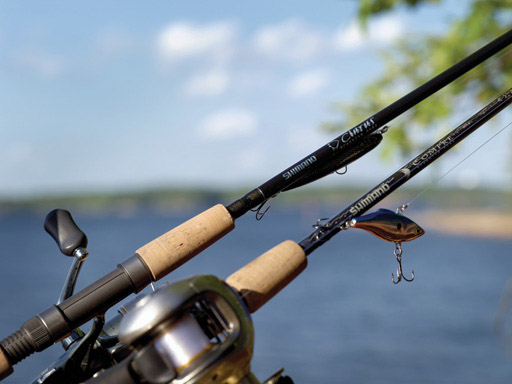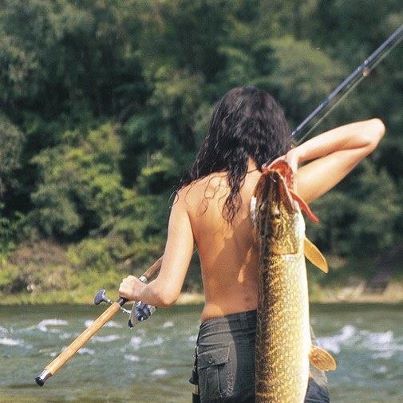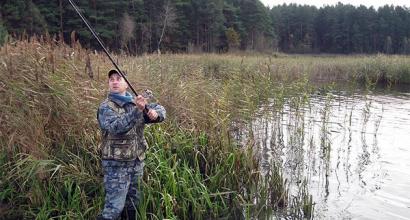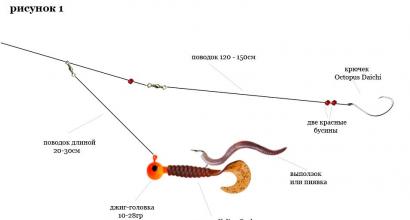Choosing a spinning rod: How to choose the right spinning rod
How to choose a spinning rod - Almost every angler has asked this question at least once in his life. If you decide to buy a spinning rod, then I advise you to find an experienced angler among your friends, let him help you make a choice. Before going to the store to buy a spinning rod, you need to roughly determine the following points: the amount you are counting on, the estimated size of future trophies, the type of fishing, fishing conditions, the type and weight of artificial bait, the required casting distance.
You can, of course, try to choose, say, 2.4 meters long with a bait test of 5-25 grams. Many people, including myself, started with universal tackle, but eventually came to the conclusion that an angler's arsenal should include several specialized rods that are best suited to certain fishing conditions.
To begin with, let's figure out what a "universal" spinning with the above characteristics is. Its length - 2.4 meters - will allow you to fish comfortably both from the shore and from the boat. But this comfort will be relative, because for a boat there is nothing better than spinning with a “growth” of 1.8-2.1 meters, and for the shore - 2.7-3 meters.
A test of 5-25 grams will allow you to cast all types of baits: "turntables", "oscillators", wobblers, jig baits. However, light baits (for example, Mepps numbers 00, 0 and 1) will not fly far enough, especially if the casting technique is not “set”, and you are unlikely to feel them when reeling. And with heavy baits (for example, jig heads weighing 20 grams or more), you risk overloading the spinning, which will ultimately lead to its breakdown.
The conclusion can be drawn as follows: lovers of the "universal" will still have to compromise, and even spinning "for all occasions" has its own "scope".
Thus, before buying a spinning rod (or even asking the advice of experienced colleagues on the forum), decide in what conditions you plan to fish most often. Answer the following questions:
- What kind of body of water will it be: a deep river with a current or a stagnant bay, a shallow lake or a reservoir?
- Will you be fishing from a boat or from the shore?
- What kind of fish and what size do you intend to catch?
- Perhaps you have already decided on the type of bait? In this case, spinning should be chosen for them. For example, one model is suitable for jig fishing, a completely different one for oscillating baits, and a third one for jerkbaits.
Now is the time to decide what parameters you should pay attention to when choosing gear. There are three of them: the length of the rod, its action and the lure test.
Everything should be clear with the length, in most cases it is in the range from 1.8 to 3 meters.
Plug or telescope?

If you do not have the opportunity to transport fairly large pole rods to the place of fishing, then a telescope will come in handy.
For example, if you need to take a spinning rod with you on a business trip, then telescopic spinning is suitable for this.
After all, the only indisputable plus of telescopic rods is their compactness. But if you want to get a serious spin, then I want to advise you a compound or plug spinning rod.
How to choose the length of a spinning rod?
If you intend to fish from the shore or boat on small and medium-sized rivers, canals, ponds and lakes (about 120 m wide), then I advise you to choose a spinning length in the range of 2.1-2.7 meters. I advise you to choose a spinning rod with a length of 2.7 meters or more for those who are going to fish from the shore on large rivers, with deep holes, on large lakes and reservoirs - if necessary, long-distance casts, about 100 meters or more.
Choosing the material from which the spinning is made
Fiberglass. The advantages of rods made of fiberglass are their relative cheapness and unpretentiousness, that is, they do not require special care. But their main disadvantage is a large mass. If you actively flash, using a fiberglass rod, then your hand will get tired very quickly. Fiberglass spinning rods can only be used when trolling, where frequent casting of the bait is not required.
Composite. Composite spinning rods have average stiffness. The composite is obtained when fiberglass fibers are added to carbon fibers. I advise you to buy composite spinning rods only if you cannot afford to buy a carbon fiber rod. At the moment, a huge number of relatively inexpensive carbon fiber rods have appeared on the markets and in stores, from which you can choose a good spin.

CFRP, carbon fiber, graphite, carbon - it's the same thing. The lightest in weight are spinning rods made of carbon fiber. I advise you to choose from this material.
Carbon fiber spins differ in the modulus of graphite content M1, M2, M3, etc.
The smaller the module, the greater the flexibility and the longer the vibrations of the spinning tip decay, and this, in turn, negatively affects the casting distance and reduces the reaction speed of the rod. But you should not get carried away with large modules. More carbon fiber - more rigidity, but also fragility.
On the Internet, I quite often met with such statements that rods with more than six "coal" modules in cold weather, especially at sub-zero temperatures, become more fragile and can break. Personally, my friends and I have not encountered this, but such an opinion exists, of course, you decide. I advise you to choose from rods with optimal, in my opinion, modules of carbon fiber content, equal to five and six (M-5, M-6).
Which spinning rod test to choose?
The test is an indicator of spinning, which determines the lower and upper limits of the mass of artificial lures used. When choosing a spinning rod, you need to decide what mass of artificial lures you will use when fishing. The lower test is the minimum value of the mass of the bait. In simple terms, if the weight of the lure is equal to the value of the lower test, then when reeling such a lure you will feel its game with the rod, and if the weight of the lure is less than the value of the lower test, then when making the wiring, you will not feel the game of the bait spinning.
Lure Test (Test for short) is the most important characteristic of a rod. Shows the range of weights that the baits used must fit into. The upper limit of the test is the allowable weight limit, if you systematically exceed it, sooner or later you will break the rod. The lower limit is the minimum weight of the spinner (or jig head, or wobbler), which is able to load the spinning blank so that it “works out” and, roughly speaking, serves as a “catapult” when casting. However, remember that the manufacturer is not always honest, accurate to the gram, indicates the test of the rod, especially the lower one.
So, for example, a test of 1-5 grams means that the spinning is “sharpened” for the lightest baits. However, this does not make it impossible to catch large fish with it. It will just take longer to pull it out, and a well-tuned friction coil brake will help to avoid breakage during strong jerks.
The upper value of the test is the maximum weight of the lure that can be cast with this rod without risking breaking it. According to the mass of baits used for casting, spinning rods are ultra-light, with a test of 1-5 g, light 5-15 g, medium 7-25 g, heavy 20 or more grams, but this is all about. There are such rods on which, instead of a test, a range of recommended lines for breaking load is applied. For catching fish of small and medium sizes, as well as for the sharpness of sensations when playing, I recommend a spin with a test of 0-10 g. My personal opinion is a little pampering. In addition, such a rod requires delicate care. For fishing on small rivers and lakes of medium-sized fish, a rod with a test of 5-25 g is suitable. The sharpness of sensations when playing with such a spinning rod is very excellent. And for medium and large reservoirs, if you need long-distance casting of baits of a decent mass, a spin with a test of 20 g or more is suitable. Trolling requires sticks with a large dough, starting from 60 grams.


